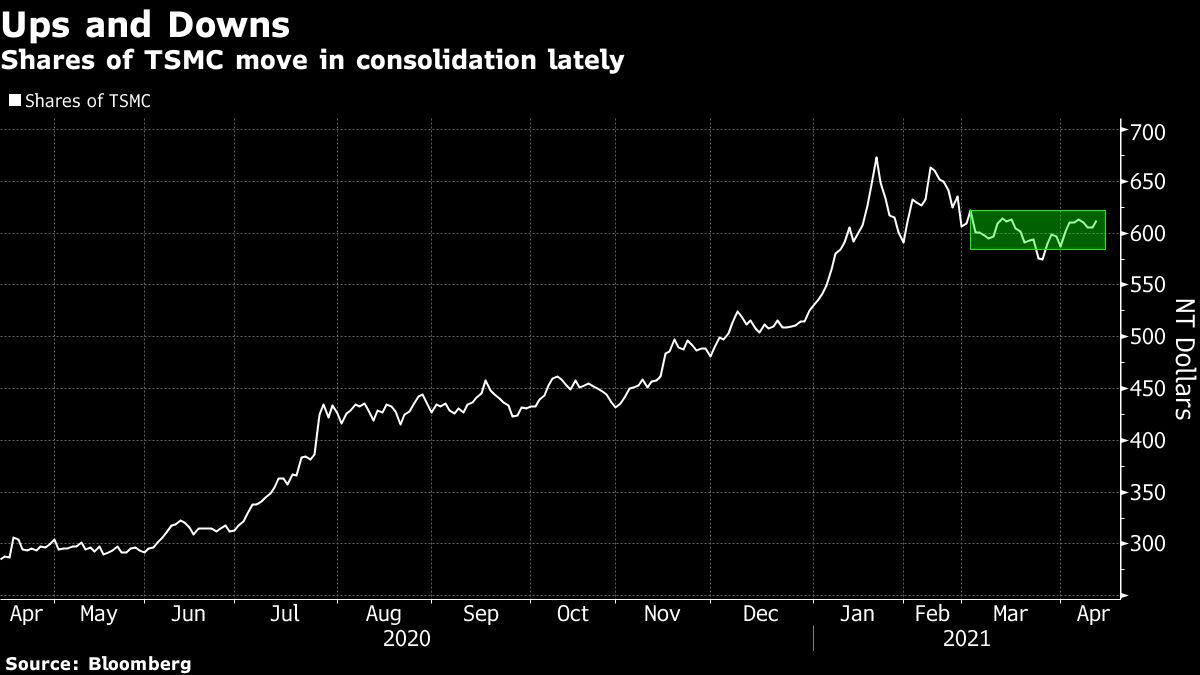TSMC Lifts Spending, Sales Targets as Chip Crunch Persists

(Bloomberg) — Taiwan Semiconductor Manufacturing Co., the world’s No. 1 maker of advanced silicon, boosted its spending and revenue growth targets for this year as global companies from carmakers to PC suppliers scramble for chips.
The world’s largest contract chipmaker said Thursday that its automaker industry clients can expect chip shortages to begin easing next quarter, alleviating some of the supply disruptions that have forced the likes of GM and Ford to curtail production. But overall deficits of critical semiconductors will last throughout 2021 and potentially into next year, Chief Executive Officer C.C. Wei told analysts on a conference call.
TSMC now expects investments of about $30 billion on capacity expansions and upgrades this year, after spending $8.8 billion in the first three months, Chief Financial Officer Wendell Huang said. The company had previously forecast spending of as much as $28 billion. Sales in the June quarter may reach $13.2 billion, beating the average $12.8 billion seen by analysts, while full-year revenue may climb 20% in dollar terms, ahead of the “mid-teens” growth predicted in January.
“We see the demand continue to be high and the shortage will continue throughout this year and may be extended into 2022 also,” said Chief Executive Officer C.C. Wei.
Surging demand for the chips that power Apple Inc.’s iPhones, smart televisions and connected cars has thrust TSMC into the center of a global supply chain crunch that has idled auto plants and fueled a shortage of popular consumer products like game consoles. While Taiwan’s largest chipmaker has kept its fabs running at “over 100% utilization,” the firm doesn’t have enough capacity to satisfy all its customers and it has pledged to invest $100 billion over the next three years to expand.
Net income for the January-March period climbed 19% to NT$139.7 billion ($4.9 billion), versus the average analyst estimate of NT$136.2 billion. Gross margin for the quarter eased to 52.4% from 54% in the three months prior, due in part to relatively lower levels of utilization and exchange-rate fluctuations. First-quarter revenue rose 17% to NT$362.4 billion, according to a company statement last week.
“TSMC is likely to achieve a CAGR (compound annual growth rate) of 15% with its $100 billion capex spending over the next three years due to better-than-expected longterm semiconductor demand,” Cathay Futures analyst Felix Hsu said in a note dated April 7.
With major American carmakers and other gadget suppliers facing a prolonged shortage of chips, U.S. President Joe Biden has proposed $50 billion to bolster semiconductor research and manufacturing at home. The initiative could aid TSMC’s plan to build a cutting-edge fab in Arizona this year that could cost $12 billion.
Shares of TSMC have more than doubled over the past year. The stock advanced 1.1% on Thursday, before the company reported earnings.
TSMC’s most-advanced technologies continued to account for nearly half of revenue, with 5-nanometer and 7-nanometer processes contributing 14% and 35% of sales, respectively. By business segment, TSMC’s smartphone business amounted for about 45% of revenue, while high-performance computing increased to more than a third, reflecting sustained demand for devices even as economies start to emerge from the pandemic.
Semiconductor shortages are cascading through the global economy. Automakers like Ford Motor Co., Nissan Motor Co.and Volkswagen AG have already scaled back production, leading to estimates for more than $60 billion in lost revenue for the industry this year.
The situation is likely get worse before it gets better. A rare winter storm in Texas knocked out swaths of U.S. production. A fire at a key Japan factory will shut the facility for a month. Samsung Electronics Co. warned of a “serious imbalance” in the industry, while TSMC itself has said it can’t keep up with demand despite running factories at more than 100% of capacity.
Read more: See How a Chip Shortage Snarled Everything From Phones to Cars
(Updates with details on gross margin in second paragraph)
For more articles like this, please visit us at bloomberg.com
Subscribe now to stay ahead with the most trusted business news source.
©2021 Bloomberg L.P.




